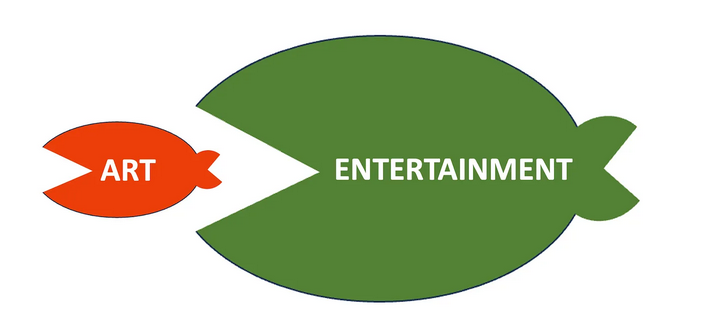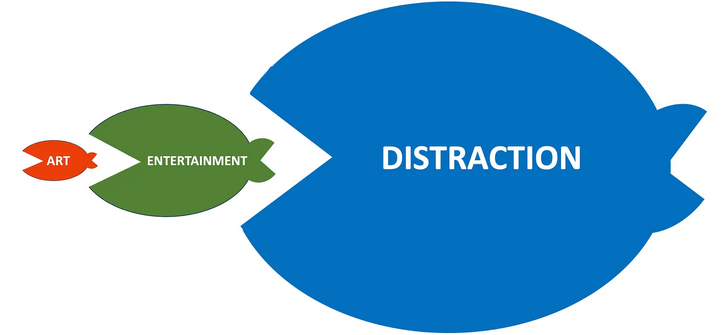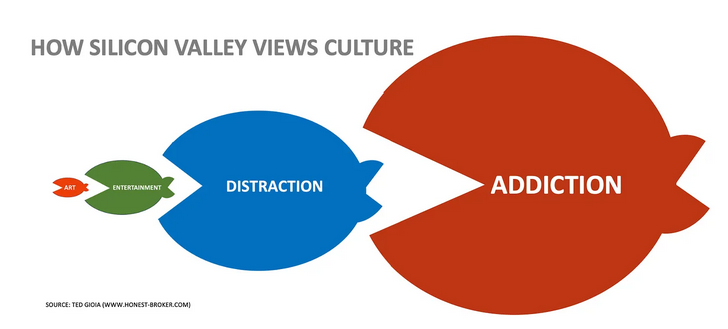Ted Gioia thinks the annual “State of the Union” address is boring, but a much more relevant thing would be a “State of the Culture” address … and he’s got lots of concerns about modern day culture:
Many creative people think these are the only options — both for them and their audience. Either they give the audience what it wants (the entertainer’s job) or else they put demands on the public (that’s where art begins).
But they’re dead wrong.
Maybe it’s smarter to view the creative economy like a food chain. If you’re an artist — or are striving to become one — your reality often feels like this.
Until recently, the entertainment industry has been on a growth tear — so much so, that anything artsy or indie or alternative got squeezed as collateral damage.
But even this disturbing picture isn’t disturbing enough. That’s because it misses the single biggest change happening right now.
We’re witnessing the birth of a post-entertainment culture. And it won’t help the arts. In fact, it won’t help society at all.
[…]
Here’s a better model of the cultural food chain in the year 2024.
The fastest growing sector of the culture economy is distraction. Or call it scrolling or swiping or wasting time or whatever you want. But it’s not art or entertainment, just ceaseless activity.
The key is that each stimulus only lasts a few seconds, and must be repeated.
It’s a huge business, and will soon be larger than arts and entertainment combined. Everything is getting turned into TikTok — an aptly named platform for a business based on stimuli that must be repeated after only a few ticks of the clock.
TikTok made a fortune with fast-paced scrolling video. And now Facebook — once a place to connect with family and friends — is imitating it. So long, Granny, hello Reels. Twitter has done the same. And, of course, Instagram, YouTube, and everybody else trying to get rich on social media.
This is more than just the hot trend of 2024. It can last forever — because it’s based on body chemistry, not fashion or aesthetics.
Our brain rewards these brief bursts of distraction. The neurochemical dopamine is released, and this makes us feel good — so we want to repeat the stimulus.
[…]
So you need to ditch that simple model of art versus entertainment. And even “distraction” is just a stepping stone toward the real goal nowadays — which is addiction.
Here’s the future cultural food chain — pursued aggressively by tech platforms that now dominate every aspect of our lives
The tech platforms aren’t like the Medici in Florence, or those other rich patrons of the arts. They don’t want to find the next Michelangelo or Mozart. They want to create a world of junkies — because they will be the dealers.
Addiction is the goal.
They don’t say it openly, but they don’t need to. Just look at what they do.







I don’t do TikTok and I only visit high-brow sites such as this one. I will say this about soi-disant artists: Since the middle of the 19th century, or maybe as far back as the Renaissance, artists have been supposing that they’re more than simply producers of goods that they would like us to buy from them. Just like entertainers. During this period of immense wealth, they have been able to find enough virtue-signalling multimillionaires and billionaires to pay large sums for the most atrocious rubbish. Or, sometimes, for just the idea of atrocious rubbish. If things ever get tight, our artists might find themselves starving to death in the gutter. Some might think that that is what they deserve.
Comment by MBlanc46 — February 20, 2024 @ 14:42
I’ve seen a few TikTok videos reposted on Twit-, er, I mean “X” and they’re actually unpleasant to watch. I don’t watch TV and generally avoid modern movies, as I find the direction and camera work irritating (can you hold a camera shot for more than a few seconds once in a while?), and TikTok videos seem to distill all the elements I dislike about modern TV/movies into even shorter and even more irritating formats.
Artists, historically, used to exist in two forms: folk artists who did their work for fellow peasants and “high art” artists who did their work for rich patrons, aristocrats, religious authorities, and kings. Today, so many artists don’t want to produce anything at all that might appeal to the peasantry and even disdain producing anything to please the tastes of rich would-be patrons. Jazz music lost its mass market when the top jazz performers started trying to impress one another rather than please their (paying) audiences … making their appeal more selective is the term d’art, I believe. Visual artists did the same thing, but earlier, because they could always get governments to foot the bill.
Comment by Nicholas — February 20, 2024 @ 15:41